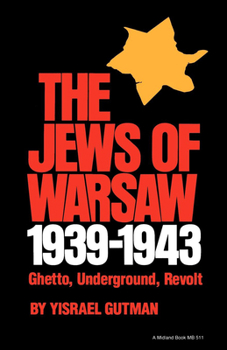Jews of Warsaw, 1939-1943: Ghetto, Underground, Revolt
(Part of the A Midland Book Series)
Select Format
Select Condition 
Book Overview
It took the Nazis longer to quell the Warsaw ghetto uprising than it had taken them to defeat entire countries. How could the Jews of Warsaw--starved and persecuted, their numbers decimated by mass deportations to concentration camps, with few weapons and no aid from outside the ghetto walls--stand up to the might of the Third Reich? To address this question, the author of The Jews of Warsaw, 1939-1943 looks beyond the ghetto uprising itself...
Format:Hardcover
Language:English
ISBN:0253331749
ISBN13:9780253331748
Release Date:August 1982
Publisher:Indiana University Press
Length:510 Pages
Weight:2.30 lbs.
Dimensions:1.6" x 6.6" x 9.6"
Customer Reviews
2 ratings
Dying like Soldiers
Published by Thriftbooks.com User , 15 years ago
By 1943, not many Jews of the Warsaw ghetto had any illusions about their fate. Hundreds of thousands of their friends and family had already been 'relocated' and the few who escaped from the 'work camps' told the ghastly story of the Nazi's Final Solution. The uprising in Warsaw was ultimately doomed, even before it began, but it is a testament to what could be accomplished if people were given the truth and a gun. Most of the key organizers knew they would die, but to die fighting rather than trapped in a death camp, was a glorious and heroic end. That they held out longer than the entire Polish army is truly amazing considering their lack of adequate weapons and training. A well-written, gripping, and inspirational story. The Jews of Warsaw derserve to be remembered for all time.
Unique insider perspective of first Warsaw Uprising Genesis
Published by Thriftbooks.com User , 20 years ago
One of the few surviving participants of the first Warsaw Uprising, the revolt of the remaining Jewish Ghetto in April 1943, writes a detailed multi approach history of the genesis, development, eradication, resistance, and final death throes rebellion of the Jewish ghetto in Warsaw.Yisrael Gutman conducts a review of the "life" of the Warsaw Ghetto from September of 1939 to April-May 1943. The strengths of the book are its detailed research, and the fluency of the author in several of the target languages, i.e German, Polish, Hebrew. The weakness is the absence of any review of the fierce theological debate that raged in side the Jewish community, shaped its perceptions, actions, and functions down to the last shot.The meticulous research is evident from early in the book to the last page. Gutman quotes the pre war intent of Adolf Hitler as captured in speeches and comments to other leaders "the Jews will be annihilated here [Czechoslovakia]" and "the Jews will disappear from Europe." What Gutman also does is spend a carefully crafted paragraph on pg 11 that identifies the deeply intertwined transition from war to peace and the crumbling of policy towards Final Solution as total war engulfs first Poland, and then all of Europe. This constant evolving of competing policy programs, aims, and designs is well summarized on [13].Using the archives of Ringleblum, as well as other primary source material, Gutman carefully reconstructs the first months of the German occupation of Warsaw [33], the setting of the conditions for "slowly boiling the frog" and the establishment of the ghetto system throughout occupied Poland. Gutman could explain better the "dumping" policies of both Soviet Russia and Germany into the General Government area of Poland, but overall explains the first stages and the establishment of the Jewish quarter well.Gutman also does a good job of explaining the prompt establishment of active passive resistance, both as a necessity for survival, and as a way to indirectly confront and combat the occupation regime of the Nazi party and the German Army. He details the German authorities, Jewish authorities and interactions, but the section would profit from a more detailed examination of the interaction of the Polish milieu of Warsaw, good, bad, and indifferent.Gutman also does a fine job of cross referencing other materials, such as Czeslaw Madajczyk's Policy of the Third Reich in Occupied Poland, to refer the reader to important sources of information that while additive in value, exceed the scope of Gutman's thesis. Gutman also does a concise wrap up of activities outside the ghetto, and ghettos of Nazi empire, as blitzkrieg turns to total war in Poland, and then in Central Europe and into Soviet Russia in 1941. Without trying to provide exhaustive coverage of it all, he nonetheless strives to explain the sequential impact of simultaneous forces in the war, the prosecution of occupation and economic exploitation, and as the war





